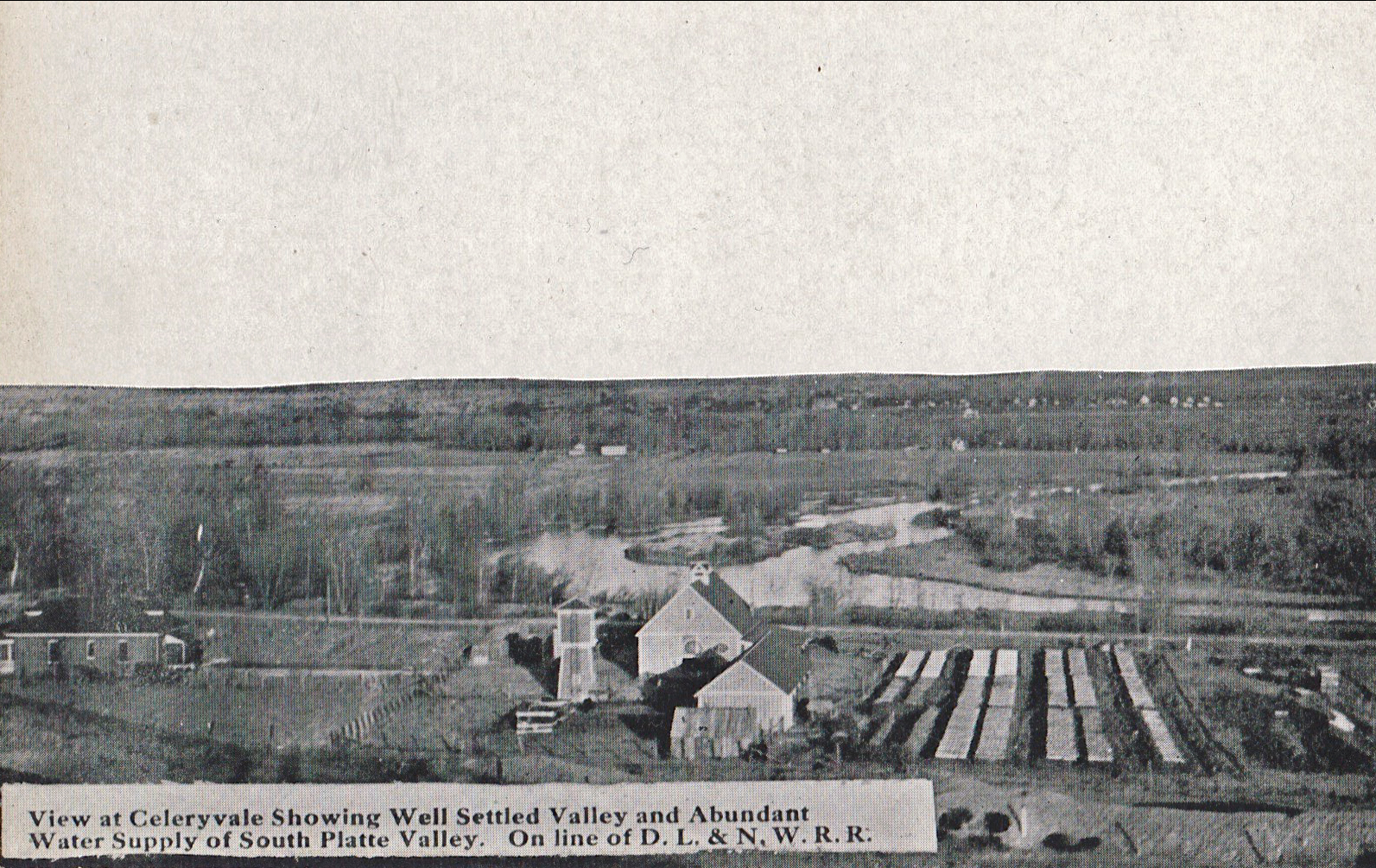Celeryvale was a farm or collection of farms about a mile west of Brighton, possibly owned by a person named Z.J. Fort, which raised Pascal celery and merited a station on the Denver, Laramie, & Northwestern (D L & NW) Railroad line. This station was propitiously placed, as Celeryvale reportedly shipped as many as one hundred cars of celery per year.
The D L & NW was incorporated in 1906 and headquartered in Laramie, WY, with offices in Denver. The plan was to build a rail line that would run from Denver to Seattle via the southwest corner of Yellowstone National Park. As it was, the line only made it as far as Greeley. The company’s engines, painted red, became known as the “Red Torpedoes.” Like the Union Pacific line, the D L & NW ran from Denver on a north-south path along the South Platte, but unlike the Union Pacific, it ran on the west, as opposed to the east, side of the river.
Like other railroads , the D L & NW got into the real estate business. It envisioned a string of towns which would become trade centers in the predominantly agricultural regions of northern Colorado. In January of 1910 the D L & NW began operating three round trips per day between Greeley and Denver, with a running time between Denver and Greeley of one hour and fifty-five minutes, including stops at sixteen stations. Going north out of Denver, those stations most likely were Welby, Clem, Poor Farm, Celeryvale, Wattenburg, Ady, Traceyville, Vollmar, Moore, Hodgson, Fort St. Vrain, Milliken, Adna, Elm, and Blandin.
The Traceyville (also spelled Tracyville) station served Fort Lupton and was located 1 1/2 miles due west of the town. Traceyville probably wasn’t a town, per se, but it was certainly in a prime agricultural spot. It may have seen some coal mining, too. A January 1912 article in the Laramie (Wyoming) Republican newspaper predicted that “Traceyville will be able to ship 200 tons a day within a month.”
The town of Milliken is named for attorney John D. Milliken, who was the principal investor in the D L & NW. He brought to the D L & NW 20 years of experience as legal counsel for the Union Pacific Railroad and a dozen years in the same capacity for the Rock Island Railroad.
The D L & NW was a failure. It permanently discontinued service on September 2, 1917. Its story was that of a small railroad company which tried but failed in the face of domination by much larger established companies, such as Union Pacific. It did not help that its route paralleled the Union Pacific’s main line north out of Denver and cut through territory already served by the Great Western Railway and the Colorado & Southern (C&S). A good example of Union Pacific’s domination was its laying of 25 miles of track from Dent, which was seven miles west of LaSalle, to Fort Collins, thereby blocking the D L & NW.
REFERENCES:
- “Board Re-elected,” The Laramie Republican dated January 22, 1912, at https://wyomingnewspapers.org/?a=d&d=WYLRP19120122-01.1.6&e=——-en-20–1–img-txIN%7ctxCO%7ctxTA——–0——
- Coloradoencyclopedia.org at https://coloradoencyclopedia.org/article/denver-laramie-northwestern-railroad .
- “Crossroads in Eden: The Development of Fort Lupton, 1835 – 2000,” October 2003, by Adam Thomas.
- “Public Utilities Reports Annotated,”1917, pp. 746 – 747 & 749. Found in Google Books at https://books.google.com/
- The Tiller and Toiler, Larned, Kansas, dated December 10, 1909, page 11 at www.newspapers.com
- “The Western Fruit Jobber” of the Western Fruit Jobbers Association of America, Vol. 2, May 1915, at https://books.google.com/books?id=gwkkAQAAIAAJ&pg=RA1-PA13&lpg=RA1-PA13&dq=%E2%80%9CThe+Western+Fruit+Jobber%E2%80%9D+of+the+Western+Fruit+Jobbers+Association+of+America,+Vol.+2,++May+1915.&source=bl&ots=XiOSAM0G3w&sig=ACfU3U0Fgq-z-GMHyLByxF-wTUP2mgawew&hl=en&sa=X&ved=2ahUKEwi829j66MDyAhWBFzQIHaYfDeUQ6AF6BAgCEAM#v=onepage&q=%E2%80%9CThe%20Western%20Fruit%20Jobber%E2%80%9D%20of%20the%20Western%20Fruit%20Jobbers%20Association%20of%20America%2C%20Vol.%202%2C%20%20May%201915.&f=false

